Billard game of giant planets
A group of scientists has discovered a new planet that moves abnormally around its host star. The planet is called WASP-17 and revolves around a star located 1,000 light years from Earth.
It was discovered by the WASP project implemented by the UK space agency in cooperation with the Geneva Observatory. This finding helps clarify how planetary systems form and grow. The Astrophysical Journal details are published today, August 12, 2009.
The planet formed from a rotating gas cloud of the same type that formed with stars, so they would have moved in the same direction as the stars. David Anderson, a graduate student at Keele University, with Amaury Triaud from Geneva Observatory, was surprised to discover that the WASP-17 is rotating in a strange orbit, becoming the first planet to have 'reverse' trajectory. The most likely explanation is that when WASP-17 was formed, it had collided with another planet.
WASP-17 seems to be a victim of interplanetary billiard game, it was hit by a planet of the "elder" and thus has an unusual trajectory like today. Professor Coel Hellier, a lecturer at Keele University, commented: 'Shakespeare once said that two planets could not occupy an orbit together, just like two kings could not co-rule a country; The case of WASP-17 proved what he said. '
David Anderson added: 'The newly formed solar system is a very harsh place. It is thought that a Mars-sized planet that once collided with the newly formed Earth and debris extracted from the planet formed the moon today. Similarly, a close-range collision that occurred during the harsh early stages of the planetary system could produce tremendous force, its WASP-17 moving backwards orbit.
 Sketch of two nearby planets outside the solar system. (Photo: KASI / CBNU / ARCSEC.)
Sketch of two nearby planets outside the solar system. (Photo: KASI / CBNU / ARCSEC.)
The first sign of the anomaly of WASP-17 is its oversized size. Although the volume is only half that, the planet is twice the size of Jupiter, becoming the largest planet known to man today.
Astronomers have long questioned why some extrasolar planets are much larger than their original conjecture, and WASP-17 helped find the answer. Scattered in an elliptical orbital trajectory, the planet is affected by extreme tidal suction. Compression and stretching under the influence of tidal attraction will heat these giant gas planets, making it bulge to the size that we see.'The material of this planet is only as thick as the expanded polystyren, 70 times less concentrated than our Earth,' said Professor Hellier.
Professor Keith Mason, head of the Council for Technology and Science Applications, which funded the research program, said: 'This is an exciting new discovery and the next big success. of the WASP group. Not only did they locate the distant and mysterious planets, but they also revealed many things about how planetary systems, including our solar system, formed and developed. The WASP team once again demonstrated why this project is currently the most successful project in the field of alien planet research. '
WASP-17 is the 17th new alien planet discovered by the Wide-Area Planetary Research Project (vWASP) developed by UK universities. The WASP team discovered the planet using a series of cameras that monitor hundreds of thousands of stars, searching for changes in their light when a planet passes by. The Geneva Observatory then measured the mass of WASP-17 and found it to be exactly the mass of a planet.
- Game 'Disorder': suspect a second iCMS
- Unknown mystery about planets outside the solar system
- Alien life 'hiding' on the moons far from us?
- Discover more 18 large planets
- GameVui.com launches Cam Cam game
- The planet is 2,500 times larger than Earth
- Glass Kepler discovered two giant planets
- Why are planets spherical, and meteorites?
- The process of forming giant planets in the universe
- Discovered two planets that closely resemble the earth
- Planet of the Solar System is lost in the universe
- Discovering new features of Neptune
 Van Allen's belt and evidence that the Apollo 11 mission to the Moon was myth
Van Allen's belt and evidence that the Apollo 11 mission to the Moon was myth The levels of civilization in the universe (Kardashev scale)
The levels of civilization in the universe (Kardashev scale) Today Mars, the sun and the Earth are aligned
Today Mars, the sun and the Earth are aligned The Amazon owner announced a secret plan to build a space base for thousands of people
The Amazon owner announced a secret plan to build a space base for thousands of people